Enhanced TDS
Identification & Functionality
- Chemical Family
- RTU Product Type
- Technologies
- Product Families
Features & Benefits
- Ready-to-Use Product Features
- Product Features
- Very high resistance to mechanical and electrical stresses
- Very high resistance to thermal shock
- Excellent long-term behaviour in relation to breakdown strength
Applications & Uses
- Composites Processing Methods
- Cure Method
- Product End Uses
- Markets
- Applications
- Processing Methods
Conventional casting with stagewise curing, or pressure gelation or automatic pressure gelation casting (PG or APG process).
- Remarks
- Prefilled, liquid products always show small filler sedimentation.
- Before partial use we recommend to stir up carefully the components or to use each container as complete unity.
- System Preparation
General instructions for preparing liquid resin systems
- Long pot life is desirable in the processing of any ARALDITE® casting resin system. Mix all of the components together very thoroughly at room temperature or slightly above and under vacuum. Intensive wetting of the filler is extremely important.
Proper mixing will result in:
- better flow properties and reduced tendency to shrinkage
- lower internal stresses and therefore improved mechanical properties on object
- improved partial discharge behaviour in high voltage applications.
- For the mixing of medium- to highviscous ARALDITE® casting resin systems and for mixing at lower temperatures, we recommend special thin film degassing mixers that may produce additional self-heating of 10 - 15 K as a result of friction. For low viscous ARALDITE® casting resin systems, conventional anchor mixers are usually sufficient.
- The prefilled ARALDITE® resin and ARADUR® hardener can be stored at elevated temperature (about 60°C) for up to about 1 week, de-pending on formulation. Intermittent agitation during storage is advisable to prevent filler sedimentation.
- Mixing time can vary from 0.5 to 3 hours, depending on mixing temperature, quantity, mixing equipment and the particular application. The required vacuum is 0.5 to 8mbar. The vapour pressure of the individual components should be taken into account.
- Application Information
- ARALDITE® CW 1226-1 / ARADUR® HW 1226-1 is used for manufacture of electrically insulating components for medium and high voltage indoor equipment, such as switch and apparatus components, bushings and instrument transformers.
- ARALDITE® CW 1226-1 / ARADUR® HW 1226-1 is used for mechanically loaded construction parts
Technical Details & Test Data
- Electrical Properties
Condition : at 23°C, cured for 6h at 80°C+ 10h at 130°C
Property Value Unit Test method Breakdown strength (measured on speciment with embedded electrodes) 18 - 20 kV/mm IEC 60243-1 Diffusion breakdown strength HD 2 - DIN/VDE 0441/1
Temperature of specimen after test < 25 °C - HV arc resistance 182 - 186 s ASTM D 495 Tracking resistance (Test solution A) > 600 M-0.0 IEC 112 Tracking resistance (Test solution B) > 600 M-0.0 IEC 112 Electrolytic corrosion effect A-1 - DIN 53489 Fig.6.1: Loss factor and dielectric constant as a function of temperature (measurement frequency: 50 Hz) (IEC 56250)
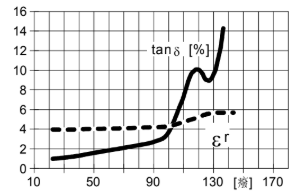
Fig.6.2:Volume resistivity as a function of temperature (measurement voltage: 1000 V) (IEC 60093)
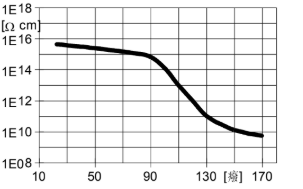
Fig.6.3: Breakdown field strength (Ed) in function of temperature DIN/ VDE 0303 / part 2 (raising test) Test specimen with embedded sphere electrodes
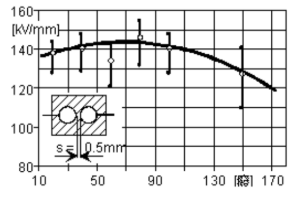
Fig.6.4: Breakdown field strength (A) and holding field strength (B) in function of storage time (55°C/ 95%rh) Test specimen with embedded sphere electrodes DIN/ VDE 0303/ part 2 A = raising test; B = 5 min step test.
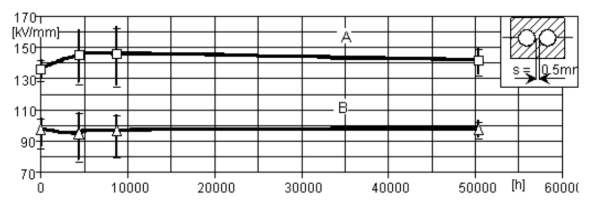
- Specific Instructions
The effective pot-life is about 2 days at temperature below 25°C. Conventional batch mixers should be cleaned once a week or at the end of work. For longer interruptions of work, the pipes of the mixing and metering installations have to be cooled and cleaned to prevent sedimentation and/or undesired viscosity increase. Interruptions over a weekend (approx. 48h) without cleaning are possible if the pipes are cooled at temperature below 18°C.
Mould temperature APG process 140 - 160°C Conventional vacuum casting 70 - 100°C Demoulding times (depending on mould temperature and casting volume)
APG process 10 - 40 min Conventional vacuum casting 5 - 8h Cure conditions APG process (minimal postcure) 4h at 130°C or 3h at 140°C
Conventional vacuum casting 12h at 130°C or 8h at 140°C
- To determine whether crosslinking has been carried to completion and the final properties are optimal, it is necessary to carry out relevant measurements on the actual object or to measure the glass transition temperature.
- Different gel and postcuring cycles in the manufacturing process could influence the crosslinking and the glass transition temperature respectively.
- Viscosity increase and gel time at various temperatures
Processing Viscosities :
Fig.4.1:Viscosity increase at 40, 60 and 80°C (measurements with Brookfield)

Fig.4.2: Initial viscosity in function of temperature (measurements with Brookfield)
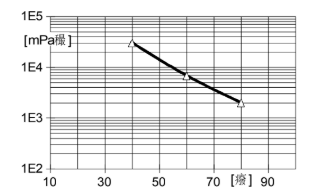
Gelation Curing Time :
Fig.4.4: Geltime measured in function of temperature (measurement with Gelnorm Instrument / DIN 16945/6.3.1)
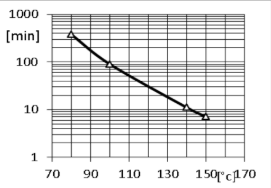
- Mechanical & Physical Properties
- Condition : at 23°C, cured for 6h at 80°C+ 10h at 130°C
Property Value Unit Test method Tensile strength 75 - 85 N/mm² ISO R 527 Elongation at break 1.2 - 1.7 % ISO R 527 E modulus from tensile test 9,600 - 10,100 N/mm² ISO R 527 Flexural strength at 23°C 120 - 130 N/mm² ISO 178 Surface strain at 23°C 1.5 - 2.0 % ISO 178 Compressive strength 140 - 150 N/mm² ISO 604 Compression set 6 - 7 % ISO 604 Impact strength 11 - 13 kJ/m² ISO 179 Critical stress intensity factor (KIC) 2.3 - 2.7 MPa·m¹/₂ Double Torsion Test
Specific energy at break (GIC) 550 - 650 J/m² Double Torsion Test
Martens temperature 90 - 100 °C DIN 53458 Heat distortion temperature 95 - 105 °C ISO 75 Glass transition temperature 90 - 105 °C IEC 1006, DSC Coefficient of linear thermal expansion (20 - 60°C) 36 - 40 10⁻⁶ K⁻¹ DIN 53752 Thermal conductivity 0.8 - 0.9 W/m·K ISO 8894-1 Flammability HB (4 mm), V1 (12 mm) - UL 94 Water absorption, 10 days at 23°C 0.10 - 0.20 % by wt. ISO 62 Water absorption, 60 min at 100°C 0.10 - 0.20 % by wt. ISO 62 Decomposition temperature 350 °C DTA Density (Filler load: 60% by wt.) 1.75 - 1.80 g/cm³ DIN 55990 Fig.5.1: Shear modulus (G') and mechanical loss factor (tan) as a function of temperature (measured at 1 Hz) (ISO 6721-7, method C)
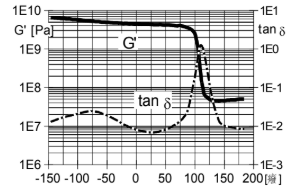
Fig.5.2: Coefficient of linear thermal expansion (α) as a function of temperature (reference temperature: 23°C) (ISO 11359-2)
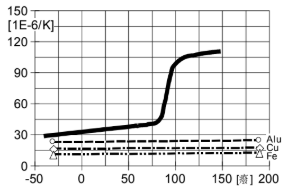
Safety & Health
- Industrial Hygiene
Mandatory and recommended industrial hygiene procedures should be followed whenever our products are being handled and processed.
- First Aid
- Contamination of the eyes by resin, hardener or casting mix should be treated immediately by flushing with clean, running water for 10 to 15 minutes. A doctor should then be consulted.
- Material smeared or splashed on the skin should be dabbed off, and the contaminated area then washed and treated with a cleansing cream. A doctor should be consulted in the event of severe irritation or burns.
- Contaminated clothing should be changed immediately.
- Anyone taken ill after inhaling vapours should be moved out of doors immediately. In all cases of doubt call for medical assistance.
- Handling Precautions
protective clothing yes gloves essential arm protectors recommended when skin contact likely
goggles/safety glasses yes respirator/dust mask recommended Skin protection Apply barrier cream to exposed skin.
before starting work Apply barrier or nourishing cream.
after washing Dab off with absorbent paper, wash with
Cleansing of contaminated skin warm water and alkali-free soap, then dry with disposable towels. Do not use solvents.
Clean shop requirements Cover workbenches, etc. with light coloured paper. Use disposable breakers, etc.
Disposal of spillage Soak up with sawdust or cotton waste and deposit in plastic-lined bin.
Ventilation: of workshop Renew air 3 to 5 times an hour.
of workplace Exhaust fans. Operatives should avoid inhaling vapours.
Storage & Handling
- Storage Conditions
- ARADUR® HW 1226-1 CI HARDENER contains accelerator. Prolonged storage at high ambient temperatures results in an undesirable increase in its viscosity and impairs the reactivity of the mixture.
- ARADUR® HW 1226-1 CI HARDENER is sensitive to moisture. Partly emptied containers must be resealed immediately.
- The components have to be stored under dry conditions at 6 - 35°C, in tightly sealed original containers.
- Under these conditions, the shelf life will correspond to the expiry date stated on the label.
- After this date, the product may be processed only following reanalysis.
- Partly emptied containers should be closed tightly immediately after use.
- Prefilled, liquid products always show small filler sedimentation.
- Before partial use we recommend to stir up carefully the components or to use each container as complete unity.
